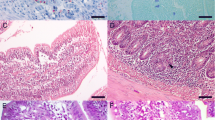Abstract
Defense mechanisms of a host against Fonsecaea pedrosoi infection were studied histopathologically using athymic nude (nu/nu) mice of BALB/c background and their heterozygous (nu/+) littermates. Thirty male nu/nu and 30 nu/+ mice, weighing 16–19 g, were employed in this experiment. The nu/nu or nu/+ mice were divided into 3 groups consisting of 10 each. Furthermore, 4 nu/nu mice were supplemented to investigate effects of lymph node cell transfer. Subglobose cells of F. pedrosoi Tsuchiya strain were obtained from a culture in brain heart infusion glucose (1%) broth with reciprocal shaking at 37 °C for 17 days, and then 0.02, 0.1 and 0.5% cells suspensions were prepared. Each cell suspension was allotted to one group of the nu/nu or nu/+ mice. 0.1 ml of the cell suspension was inoculated into a tail vein, then one mouse from each group was sacrificed 1, 2, 4, 6, 8, 10, 14, 18, 21 and 25 days after inoculation. In both the nu/nu and nu/+ mice, the brain, kidneys and heart were affected severely with the strain in that order. Histopathologically, the defense mechanisms of the nu/+ mice against the fungus infection consisted chiefly of 2 steps: first, of non-immune phagocytosis by polymorphonuclear leucocytes (PMNs), and second, of granuloma formation induced by cell-mediated immunity. Those of the nu/nu mice consisted only of one step: phagocytosis by PMNs. A difference in susceptibility to the strain between the nu/nu and nu/+ mice changed according to the amount of the fungal cells inoculated. When inoculated with the 0.02% cell suspension, the resistance of the nu/nu mice was stronger than that of the nu/+ mice. In contrast, when inoculated with the 0.5% cell suspension, the former was affected more severely than the latter. There were little differences in the susceptibility to the strain between the nu/nu and nu/+ mice inoculated with the 0.1% cell suspension. These data seem to indicate that the phagocytic function of PMNs of the nu/nu mice was more active than that of the nu/+ mice, and the nu/nu mice inoculated with the 0.5% cells suspension (beyond the phagocytic capacity) lost resistance against the fungus infection. When the nu/nu mice were transferred with lymph node cells before inoculation of the strain, granulomata were formed to prevent hyphae from growing freely in the tissue.
Similar content being viewed by others
References
Aravysky, R. A. & Aronson, V. B., 1968. Comparative histopathology of chromomycosis and cladosporiosis in the experiment. Mycopathol. Mycol. appl. 36: 322–340.
Beaman, L., Pappagianis, D. & Benjamini, E., 1977. Significance of T cells in resistance of experimental murine coccidioidomycosis, Infect. Immun. 17: 580–585.
Burns, W. H., Bullups, L. C. & Notkins, A. L., 1975. Thymus dependence of viral antigens. Nature (London) 256: 654–655.
Corbel, M. J. & Eades, S. M., 1977. Experimental mucormycosis in congenitally athymic (nude) mice, Mycopathol. 62: 117–120.
Cutler, J. E., 1976. Acute systemic candidiasis in normal and congenitally thymus-deficient (nude) mice, J. Reticuloendothel. Soc. 19: 121–124.
Emmons, C. W., Binford, C. H., Utz, J. P. & Kwon-Chung, K. J., 1977. Medical Mycology (3rd edition. Chromomycosis p. 386–405, Lea, Febiger, Philadelphia.
Felger, C. E. & Friedman, L., 1962. Experimental cerebral chromoblastomycosis. J. Infect. Dis., 111: 1–7.
Graybill, U. R. & Drutz, D. J., 1978. Host defense in cryptococcosis. II. Cryptococcosis in the nude mouse, Cell. Immunol., 40: 263–274.
Iwatsu, T., Miyaji, M., Taguchi, H., Okamoto, S. & Kurita, N., 1979. Skin test-active substance prepared from culture filtrate of Fonsecaea pedrosoi, Mycopathol. 67: 101–105.
Kurita, N., 1979. Cell-mediated immune responses in mice infected with Fonsecaea pedrosoi, Mycopathol., 68: 9–15.
Kurup, P. V., 1971. Pathogenicity of Phialophora pedrosoi, Mykosen, 14: 41–44.
Mikami, Y., Yokoyama, K. & Arai, T., 1978. Fungal infection and macrophage, Jpn. J. Med. Mycol. 19: 202–206.
Miyaji, M. & Nishimura, K., 1977. Relationship between proteolytic activity of Aspergillus fumigatus and the fungus' invasiveness of mouse brain. Mycopathol., 62: 161–166.
Miyaji, M., 1979. Pathogenicity of Cryptococcus neoformans. Chiba Medical Journal, 55: 1–12.
Miyaji, M., Chandler F. W. & Ajello, L. Experimental histoplasmosis capsulati in athymic nude mice. Mycopathol., in press.
Nieuwerkerk, H. T. M., Lowenberg, B., van Bekkum, D. W., 1974. In vivo studies on immunological reconstitution of nude mice, p. 175–181. In J. Rygaard and C. O. Povlsen (eds.. Proceedings of the first international workshop in nude mice. Gustav Fischer Verlag, Stuttgart.
Nishimura, K. & Miyaji, M., 1979. Histopathological studies on experimental cryptococcosis in nude mice. Mycopathol., 68: 145–153.
Nomoto, K., 1978. Characteristics of infection in nude mice. Modern Media. 24: 389–400.
Shiraishi, A., 1978. Studies on the host defense mechanisms against Aspergillus infection. Chiba Medical Journal, 54: 297–304.
Shiraishi, A., Nakagaki, K. & Arai, T., 1979. Experimental sporotrichosis in congenitally athymic (nude) mice. J. Reticuloendothel. Soc., 26: 333–336.
Williams, D. W., Graybill, J. R. & Drutz, D. J., 1978. Histoplasma capsulatum infection in nude mice. Infect. Immun., 21: 973–977.
Wortis, H. H., Nehlsen, S. & Owen, Y. J. J., 1971. Abnormal development of the thymus in ‘nude’ mide, J. Exp. Med., 134: 681–692.
Author information
Authors and Affiliations
Rights and permissions
About this article
Cite this article
Nishimura, K., Miyaji, M. Defense mechanisms of mice against Fonsecaea pedrosoi infection. Mycopathologia 76, 155–166 (1981). https://doi.org/10.1007/BF00437196
Issue Date:
DOI: https://doi.org/10.1007/BF00437196




